MEGATRENDS


•
•
•
•
• Oracle


•






•
•
•
•
• Oracle


•




A ccordingtofabledUSstockmarket maketraderJessieLivermore‘thebigswings Livermorethebigmoney’.
wasusedbyEdwinLefervreinasthebasisforthecharacterofLarryLivingstone hisinvestmentclassiReminiscencesofaStock Operator.Thebestsellingbook,dedicatedtohis samememory,waspublishedacenturyagobutthis evidenttruthoftheimportanceofthebigpictureis inthedominantinvestmentthemesofthelastfewdecades. muchAswestartanewyear,investorsshouldhaveas ofaneyeonthebigstructuralthemesthey toshouldbeinvestinginnowfor2030aswhat’sgoing workin2023.
trendsInthisarticleweexaminesomeofthemegawhichtheexpertsthinkcouldholdswayin waystheremainderofthisdecadeandbeyondaswellas ofplayingthem.
IDENTIFYING‘THEBIGSWINGS’ Evenforthosewhohavefollowedmarketsfor alongtime,spottingthesebigthemesand understandingthedriversisnoeasytask. calledThe1960swasmarkedbytherallyinthesoNiftyFifty,whichwereUSgrowthstockswith consistentlyhighearningsgrowthandhighpriceto earningsratiosheavilyfavouredbyinstitutions. Theearly1970ssawtheNiftyFiftystockbubble burstwhiletheglobalrecoveryfromtheoilcrisis of1973sawaresurgenceofriskappetitewith moneyflowingoutoftheUSandintooverseas atmarkets,particularlythoseconsidered‘emerging’ thetime.
The past seven decades each had distinct investment trends that have made investors lots of money. What’s going to be the megatrend for the current decade?
This week’s main feature explores the big themes for the 2020s and beyond identified by various investment experts. It also looks at the investment funds targeting these themes.

The125-year-oldpawnbrokerisprofiting fromthecost-of-livingcrisis
I ntimesofeconomicstrife,pawnbrokers typicallyseeapick-upintradeascashmoneystrappedindividualsseekwaysofgetting boomingtohelppaythebills.Businessiscertainly forpawnbrokerH&T(HAT:AIM)whose 2020sharepricehasmorethandoubledsinceOctober andupbymorethan60%overthepastyearalone. newInrecentyearsH&T,whichalsosellshighquality reratedandpre-ownedjewelleryandwatches,has fromanasset-backedincomestocktoan excitinggrowthsharegearedintotheinflationinducedsqueezeoncustomerfinances. onThesharesremainattractivelyvalued,trading andasingle-digitmultipleofShoreCapital’s2023 dividend2024earningsestimatesandofferingaripe yieldof5%.
WHYISPAWNBROKINGMAKINGACOMEBACK? Pawnbrokingstruggledduringthepandemicas andlockdownsblockedoffmanyavenuesforspending enabledpeopletopaydowndebt,but theindustryisnowexperiencingaboomas financiallydistressedcustomersseekcashtohelp makeendsmeet.
straitenedAloanfromapawnbrokerisappealingduring economictimesasitisoftenthe easiestwayforconsumers,manywithpoorcredit bills.histories,toobtainaquickloanandhelppaytheir investorsGiventheworseningUKeconomicbackdrop, havebidupthesharepricesofH&TandrivalpawnbrokerRamsdens(RFX:AIM) accordingly.
HOWISH&TPOSITIONED?
H&T is one of the few companies benefiting from the cost-of-living crisis. Its share price continues to rise, and it is expected to see a sharp jump in profit.
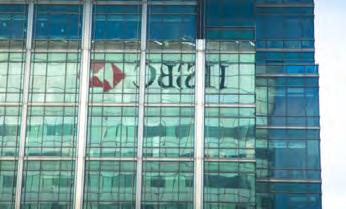
FoundedinLondonin1897asHarvey& 2022,Thompson,H&Tcelebratedits125thanniversaryin First-halfayearofstronggrowthacrossthebusiness. resultstoJune2022showeda43%surgeinpre-taxprofitto£6.7millionamid continuedmomentuminthecorepawnbroking business.ShoreCapitalforecastsfullyearadjusted pre-taxprofitsjumpingfrom£10millionto£19.1 377p.millionwithyear-endnetassetvaluepershareof profitsItestimatesthecompanywillgrowpre-tax to£32.6millionin2023and£39.2millionin2024. repairLastyearsawH&Tacquirewatchservicingand centreSwissTimeServicesfor£4.3millionin itsanearnings-enhancingdealthataddsanewskillto £16.9Theproductoffering.Sutton-headquarteredcompanythenraised millionoffreshcapitalbyissuingnewshares at425ptosupportloanbookgrowthandstore estateexpansion.Tellingly,chiefexecutiveChris GillespieandfinancedirectorDianeGiddyboth participatedinthefundraise,demonstratingtheir confidenceintheoutlook. H&TISTHEMARKETLEADER SpeakingtoShares,Gillespiepointsoutthatovera ofdecadeago,theUKpawnbrokingmarketconsisted dwindledroughly2,000shops.Today,thatnumberhas toabout800,butH&Tisamuchbiggerlargestbusinessthanitwasbackthenandisnowthe BeforepawnbrokerintheUK. orientated2019,H&T’sgrowthstrategywasmainly aroundunsecuredpersonallending, whichthecompanywentinto‘withgustoinabout the2013/2014’,saystheCEO,butH&Thassinceexited ‘We’reunsecuredlendingmarket. pawnbrokingnowfocusedonwhatwe’regoodat, andjewelleryretail.Andwedo otherthingssuchasforeignexchange,holiday money,chequecashingandWesternUnionmoney
Read our exclusive interview with chief executive Chris Gillespie where he talks about the opportunities for the business amid the changing landscape.
Did you know that we publish daily news stories on our website as bonus content? These articles do not appear in the magazine so make sure you keep abreast of market activities by visiting our website on a regular basis.
Over the past week we’ve written a variety of news stories online that do not appear in this magazine, including:
toHMRCwillpenaliseanyonelooking taxmanipulatethesystemtogetextra relief
What are the rules around dopensionrecyclingandhow Iavoidabigpenalty?
I’dbeinterestedinahighlevelrunthroughof Forpensionrecyclingrulesasitseemsaverygreyarea. example,ifweweretohavemoredisposable incomeifwepaidoffourmortgagewithmy pensionlumpsum,woulditbeOKtopaymore Ormoneyintomyself-employedpartner’spension? isthatrecycling?
HMRChasrulesinplacedesignedtopreventpeople relief.manipulatingthepensionsystemtogetextratax taxmanAsyousay,thisconceptisreferredtobythe as‘recycling’andappliesspecificallytoyouruseofthe25%tax-freelumpsumentitlement. recyclingIt’sprobablyeasiesttodemonstratehow someonemightworkwithanexample.Let’sassume is65yearsoldandhasaSIPPvaluedat lump£40,000.Theytakeouttheirmaximumtax-free investsum(£10,000)butratherthanspendingit, itstraightbackintotheirSIPP. ‘new’Asaresult,theygetbasic-ratetaxreliefonthe contribution(immediatelyboostingthevalue thenofthecontributionby£2,500to£12,500)andcan access25%ofthatmoney(£3,125)tax-freeaswell. Clearlysuchbehaviourpresentsasignificantrisk intotheTreasury–whichiswhyHMRChasrules Anyoneplacedesignedtopreventexcessiverecycling. whobreakstheserulesrisksbeinghit orwithanunauthorisedpaymentchargeof40% contribution.55%(dependingonthecircumstances)ofthe breachHMRCwillconsiderrecyclingtopotentially theruleswherethetax-freelumpsum
(orsums)receivedovera12-monthperiodare worthmorethan£7,500. lumpTheruleskickinwherethepaymentofatax-free sumhasresultedina30%ormoreincrease mightincontributionstoyourpensioncomparedtowhat Althoughnormallyhavebeenexpected.thismightsoundabitvague,it’s actuallyaspecificcondition–HMRClooksat youcontributionspaidintherestofthetaxyearafter yearstookyourtax-freecashplusuptotwomore contributionsafterwards.Thisisthencomparedwiththe madeduringasimilarperiodbeforetax-freecashwastaken.
pensionYoucan’tgetroundthisbypayingintodifferent contributionsschemesasHMRCwilllookatallofyour whenmakingitsassessment. youEqually,HMRCwillpenaliseyouforrecyclingif yourborrowmoneytopaycontributionsorpayinto pensionoutofsavingsandthenusethetaxfreelumpsumtopayofftheloanortopupsavings. mightIfyouareatalluncertainabouthowtheserules applyinyourspecificcircumstances,it’s worthspeakingtoaregulatedfinancialadviser beforedoinganything,particularlyifyou’rethinking aboutmakinglargecontributions.
DOYOUHAVEAQUESTIONON RETIREMENTISSUES? Sendanemailtoasktom@sharesmagazine.co.uk line.withthewords‘Retirementquestion’inthesubject We’lldoourbesttorespondinafutureedition ofShares andPleasenote,weonlyprovideinformation unsurewedonotprovidefinancialadvice.Ifyou’re adviser.pleaseconsultasuitablyqualifiedfinancial investmentWecannotcommentonindividual portfolios.


Have you ever wondered if it is possible to put money back into a pension to claim tax relief for a second time?

The taxman has a system in place to prevent people from ‘cheating the system’. Tom Selby explains the rules in his Ask Tom column.

Card
many months
AskTom:Yourretirementquestionsanswered
Pictet-Nutrition is a compartment of the Luxembourg SICAV Pictet. Any investment incurs risks, including the risk of capital loss. The latest version of the fund‘s prospectus, KIID, annual and semi-annual reports must be read before investing. Fund documentation and summary of investor rights are available free of charge in English and in local languages on assetmanagement.pictet or at Pictet Asset Management (Europe) S.A., 15 avenue J.F. Kennedy, L-1855 Luxembourg.
For over twenty-five years, our thematic equity experts have accurately identified the most rewarding themes, by carefully separating enduring megatrends from fads. Learn more at assetmanagement.pictet

If you look closer, wage growth is easing and activity in the services sector is starting to contract
Many investors might be surprised at how markets jumped on strongerthan-expected US jobs numbers on 6 January.
A tight labour market is one of the inflationary pressures which the Federal Reserve studies when it decides on interest rates. Non-farm payrolls increasing 223,000 in December against the 200,000 expected would imply a harsher line from Fed chair Jerome Powell and his colleagues, namely a case to keep raising interest rates.
However, beyond the headline there were some details around wage growth which enabled the market to take the view that the Fed could soon reduce the pace of rate hikes. Premier Miton US
Liberum thinks the investment style could recover this year
GROWTH STOCKS COULD rally in the middle of 2023, according to Liberum which has based its prediction on the analysis of historic market trends.
Liberum analysts Joachim Klement and Susana Cruz have calculated the relative performance of growth as an investment style versus the wider UK stock market in all the recessions since 1980. The pair observe that since the summer of 2022 growth stocks have closely
Opportunities (B8278F5) manager Hugh Grieves says: ‘Chairman Powell will take comfort in the fact that real wage growth is decelerating faster than expected.’
US average hourly earnings rose 0.3% in December from the previous month, against the 0.4% forecast, and 4.6% from December 2021, the lowest year-on-year increase since August 2021.
The latest ISM purchasing managers’ index data for the services sector, released concurrently with the labour market update, offered further evidence of a slowdown in the economy which might encourage the Fed to ease up on rate hikes.
The reading of 49.6 for December was far worse than the 55 the market expected and suggested the US services space is contracting. PMI surveys are a leading indicator of economic health with purchasing managers at businesses paid to react quickly to changing conditions. [TS]
followed their trajectory in an average recession.
If the trend continues into 2023, the pair expect growth stocks to underperform in the first quarter before outperforming between April and September.
Value stocks are then expected to return to favour in the final three months of the year ‘as hard-hit deep value stocks start to rally in anticipation of an end to the recession’.
Klement and Crux note stocks
deviated from the previous trend in the first half of 2022 thanks to the sell-off prompted by rising interest rates and the strength in energy prices.
Peel Hunt analysts Charles Hall and Clyde Lewis are less confident in a wider rebound in growth but feel there could be some exceptions which ‘are bettering their market positions through organic investment, new acquisitions or self-improvement’. They give the examples of Dr Martens (DOCS) and Wizz Air (WIZZ). [TS]

High-street and online apparel seller Next (NXT) brought shareholders some New Year cheer with the news that total full-price sales were up nearly 5% over the three months to the end of December rather than down 2% as previously predicted.

Interestingly, it was in-store sales which drove the increase, with the retail estate growing revenue by 12.5% against just a 0.2% rise in online revenue, albeit against a strong comparative period in 2021.
Despite anecdotal talk of shoppers having brought forward their seasonal spending, Next said it saw a ‘dramatic boost’ from the start of December with sales peaking the week before Christmas up 17% on the previous year.
This momentum continued into the postChristmas sale period driven by cold weather, which drove demand for winter clothing such as jumpers, scarves and gloves.
Broadly speaking, clothing sales seem to have held up better this year than non-food spending in general and certainly much better than spending on household goods, electrical appliances, sports
equipment,
All of which bodes well for other apparel retail firms which are due to report their results, especially those with physical shops such as Frasers (FRAS) and Marks & Spencer (MKS)
However, we are concerned that Next itself guided analysts to expect lower earnings for the year to January 2024 and we find ourselves wondering about the firm’s real underlying earnings growth potential.
From the early 1990s until around 2017, we conservatively estimate the company grew its earnings per share at a 15% compound annual growth rate, meaning profits essentially doubled every five years.
Knowing this, when times were good investors were happy to pay up to 35 times cyclically adjusted earnings and even 45 times on occasion.
In early 2017, the firm warned of a ‘bleak’ outlook and 12-month earnings subsequently flatlined at around 440p per share for two and a half years to the middle of 2019.
This was a watershed moment, as investors realised Next was no longer a double-digit growth stock, and since 2017 the shares have struggled to rerate above 15 times trend earnings.
Although 12-month earnings per share have rebounded from their 2020 low of 238p to 542p today, they are forecast to remain around this level for the next two years meaning the old trend growth rate is well and truly broken.
In that scenario, maybe the best shareholders can hope for is not a rerating but a generous stream of cash which they can reinvest in the next big growth story? [IC]
More importantly, what do they say about the firm’s own future?toys and even watches and jewellery according to data released by the Office for National Statistics.
There is mounting evidence of a downturn in the computer games industry as the impact of pressures on consumer budgets and the wider choice of leisure activities coming out of the pandemic is being felt.
The performance of relevant UK-listed firms is reflecting this reversal in fortunes, something the sector has in common with other ‘lockdown’ winners. The average decline from 12-month highs is around 43% with declines across the broad spectrum of players.
Computer games firms have slumped from their 52-week highs
Gaming research and data company Newzoo estimates spending on video gaming fell by around 4% in 2022 to $184 billion.

The report highlights changes to privacy rules for mobile users and fewer large game releases contributed most to the overall decline. The mobile market (around half the market) is forecast to have shrunk by 6%, the console market by 4% while the PC gaming market saw a small 0.5% increase.
The weakness in mobile was signaled by Take Two Interactive Software (TTWO:NASDAQ) at its second quarter results and led the firm to downgrade full-year expectations.
Nevertheless, analysts at Numis point out that industry revenues generated between 2020 to 2022 are around $43 billion higher than original forecasts, suggesting a sustained benefit.
Devolver Digital −71%
Frontier Developments −66%
Ubisoft Entertainment −57%
Tinybuild −47%
Take Two Interactive −41%
Team 17 −41%
CD Projekt −36%
Electronic Arts −13%
Activision Blizzard −11%
Average −43%
Company Price versus 12 month high Table: Shares magazine • Source: Stockopedia, 9 January 2023
What everyone wanted to know two years ago was whether the strong increase in computer gaming was a one-off related to Covid restrictions or a sustainable acceleration in the long-term growth trend.
While sector experts acknowledge spending is discretionary, they also make the case that gaming is a relatively ‘cheap’ treat, suggesting the impact from consumer weakness is not a big concern.
A profit warning (9 January) from games developer Frontier Developments (FDEV:AIM) seems to contradict this assertion. The company noted ‘increased player price sensitivity related to worsening economic conditions’ as a key factor in a disappointing Christmas trading period.
Its peer Devolver Digital (DEVO:AIM) also lowered its profit outlook the same day on weaker than expected trading in December suggesting consumer weakness might be more challenging than anticipated for the sector.
That said, it is difficult to separate general economic conditions from company-specific factors. Fellow developer Team17 (TM17:AIM) rushed out its own statement saying trading for the year to 31 December was ‘at least’ in line with market expectations.
Numis said it expects acquisitions to remain a key feature of the video gaming landscape. [MG]
Texan software and data analytics business Oracle (ORCL:NASDAQ) has been shooting the lights out for a year or more, and investors have begun to cotton on, with the stock surging 40%plus since September 2022.
The company has seen a run of upgrades after beating Wall Street estimates, most recently in its latest quarter (to 30 November). Revenues and earnings of $12.3 billion and $1.21 per share comfortably trumped estimates of $11.95 billion and $1.16,
respectively.
Oracle continues to make significant progress in shifting more of its business to the cloud, prompting analysts at US broker Piper Sandler to flag the ‘improving risk-reward’ on its cloud business, which has ‘warranted a wholesale rethink’ of the group.
Oracle’s performance in cloud services and licence-backed software surprised on the upside, reflecting growing demand from both large enterprises and government agencies. The
10-year FTSE 100 annualised total return is two-and-a-half times better than the telecom stock’s
Investors have been getting increasingly frustrated at the poor returns from Vodafone (VOD), whose share price hit 25-year lows of 83.8p in the days before Christmas. That’s from 130p levels as recently as July 2022. Little wonder that calls from activists for change and improvement have been getting louder.
For context, Vodafone shares have delivered shareholders an average 2.64% a year return,
including dividends, over the past decade. Returns from a FTSE 100 tracker would have produced a 6.33% annualised total return, according to Morningstar data.
Former CEO Nick Read stepped down at the end of 2022 after more than four years in the top job following intense pressure from critics. His tenure saw the share price lose roughly two-thirds of its value as the business struggles to compete in key markets like
company has seen a strong showing from its Cerner digital health records unit. It recently shared $9 billion of revenue with Alphabet (GOOG:NASDAQ), Amazon (AMZN:NASDAQ) and Microsoft (NSFT:NASDAQ) to provide the US Defense Department with its Joint Warfighting Cloud Capability, with the work to completed by 2028. [IC]
Germany and the UK under the strain of enormous debts. At the end of September 2022, Vodafone had more than €67.5 billion of longterm debt putting the company’s debt-to-equity ratio at about 116%.
Against such a difficult backdrop, investors will be hoping that further non-core assets can be sold, mirroring the recent sale of its Hungarian unit for €1.7 billion. [SF]
The data giant has been posting strong growth as it embraces cloud delivery
16 January: Hercules Site Services.
17 January: Crest Nicholson, Ramsdens, Safestore.
HALF-YEAR
16 January: Knights Group, Net Zero Infrastructure.
18 January: Gateley.
19 January: Ilika.
TRADING UPDATES
13 January: MJ Gleeson, Taylor Wimpey.
16 January: Ashmore, Rio Tinto.
17 January: Experian, Hays, IntegraFin.
18 January: Antofagasta, Burberry, Currys, Diploma, Hochschild, QinetiQ, Rathbones, WH Smith.
19 January: Centamin, Dunelm, Network International, PensionBee, Premier Foods, WAG Payment Solutions.
Housebuilder Taylor Wimpey (TW.) is expected to report full-year operating profits of around £920 million, in line with market forecasts, despite a ‘challenging’ market in 2022.

CHINA REOPENING IS A BOON

Luxury goods group Burberry’s (BRBY) third quarter trading update (18 January) gives investors an opportunity to check-in on festive trading at the high-end handbags-to-trench coats seller, whose wellheeled clientele are less exposed to cost-of-living
However, the real focus in its 13 January trading update will be on the 2023 sales outlook, and especially prices, as the housing market continues to slow.
If sales and cash flow are set to decline, investors could start to question the firm’s ability to continue returning cash which has been a key incentive to own the shares.
pressures than most consumers. Burberry’s impressive interim results (17 November 2022) revealed an acceleration in sales of its leather goods – a key strategic objective for the company. New product launches and
seasonal collections performed strongly. Shares in the UK’s only blue-chip luxury retailer have rallied in recent months on the expectation Burberry will benefit from the reopening of the Chinese economy and excitement surrounding new CEO Jonathan Akeroyd’s ambitious target to grow annual sales to £5 billion as Burberry refocuses on ‘Britishness’ under new designer Daniel Lee. [JC]

This week sees numerous US investment banks and one of the country’s biggest retail lenders report, and hopes are high that rising interest rates will mean an improvement in margins and profitability compared with last year.
JPMorgan Chase (JPM:NYSE) is likely to be the main focus, with the market expecting fourth-quarter
earnings per share of $3.12 and an increase in the dividend, which the bank has raised consistently for the last eight years.
Bank of America (BAC:NYSE), another big diversified financial firm, is expected to post fourth-quarter EPS of 80c while rival Citigroup (C:NYSE) is seen reporting $1.20 of quarterly earnings.
Finally, retail giant Wells Fargo (WFC:NYSE) is expected to generate earnings of 99c for the last three months of 2022.
13 January: Bank of America, Bank of NY Mellon, BlackRock, Citigroup, Delta Airlines, JP Morgan, Wells Fargo, UnitedHealth.
17 January: Goldman Sachs, Morgan Stanley, United Airlines.
18 January: Charles Schwab, Prologis, PNC Financial, Kinder Morgan.
19 January: Procter & Gamble, Netflix, American Express, Atlassian.
Streaming giant Netflix (NFLX:NASDAQ) is set to post its fourth quarter earnings on 19 January with the extent to which its new advertising-supported platform has boosted subscriber numbers being a key focus.

Seemingly well-sourced reports in mid-December suggested take-up had been disappointing and put the share price under pressure.
How the company might approach a crackdown on password sharing without alienating its customer base is another area the market will be keeping tabs on.

The Scottish Mortgage Investment Trust is a global fund seeking out the world’s most exciting growth companies and investing in them for the long term. We believe this is the best way for you to enjoy strong returns for decades to come.
And we explore a number of exciting themes in order to seek out these world-changing businesses. Transport is just one of them. Why not discover them all?
As with any investment, your capital is at risk. A Key Information Document is available on our website.
Discover what’s next. Explore the future at scottishmortgage.com Connect with us:
Issued and approved by Baillie Gifford & Co Limited, whose registered address is at Calton Square, 1 Greenside Row, Edinburgh, EH1 3AN, United Kingdom. Baillie Gifford & Co Limited is the authorised Alternative Investment Fund Manager and Company Secretary of the Trust. Baillie Gifford & Co Limited is authorised and regulated by the Financial Conduct Authority. The investment trusts managed by Baillie Gifford & Co Limited are listed UK companies and are not authorised or regulated by the Financial Conduct Authority.Many smartphone users will have access to 5G next generation mobile networks, particularly if you’re in one of the UK’s cities. This shows up as a 5G symbol in your notifications bar and you should notice faster streaming of music or video, for example.
Yet we remain years away from 5G delivering fully on its long-term potential and testing group Spirent (SPT) is one of the best ways to invest in what is increasingly being seen as a structural technological shift.
5G promises exponentially faster mobile download and upload speeds, much greater bandwidth to send the explosion of data volumes, and latency (time lag) all but eradicated. It will help enable self-driving cars in the future, robotic medical procedures performed by surgeons miles away from the patient and countless other consumer, industrial and security/ military applications.
Analysts estimate barely 30% of all telecom network operators globally have deployed initial 5G networks, and only 3% have deployed the

Price: 275p Market cap: £1.64 billion
first of many major technology upgrades. As one analyst told Shares, because 5G networks are built on software from multiple vendors and dispersed across several owned and third-party sites, the job of testing and providing assurance of components and entire networks is ‘never finished’.
5G will become increasingly mission critical to how consumers, industry and governments operate, and Spirent has spent years earning its reputation as a trusted technology testing services supplier. This is a company with a global engineering and operational footprint of the highest possible standard.
Spirent has a very strong balance sheet and is thought to have exited 2022 with more than $200 million of net cash on its books, providing a healthy safety net through uncertainty, and flexibility to meet emerging opportunities head-on. It’s worth noting that key customers like AT&T (T:NYSE) and Verizon (VZ:NYSE) have said multiple times that current macro headwinds will not delay their respective capex plans, not least because of savage competition between carriers.
Since joining as chief executive in May 2019, chief executive Eric Updyke has steered Spirent towards greater recurring revenue streams. This will help smooth out what has historically been unpredictable, project-based revenue, one of the risks that investors have previously associated with the business.
At 73% or so, Spirent has some of the highest gross margins in its industry, while operating margins have gone from 15% in 2018 to the rough 21% level anticipated for 2022. Return on equity and on investment, two important business quality metrics, are impressively running above 20%. [SF]
original issue price of the bond is returned to them after a specific period.
BlackRock – the world’s biggest money manager – believes after four decades of relatively stable economic activity and inflation known as The Great Moderation we have entered a new regime of greater macro and market volatility, requiring us to rethink the appeal of bonds.
There is a growing appreciation as we enter 2023 that after many years in the wilderness due to rock-bottom interest rates, bonds once again deserve a place in a balanced portfolio.
Howard Marks of Oaktree Capital Management argues that base interest rates are not going to return to between 0% and 2% in the future but are likely to remain between 2% and 4% for a considerable time.
In that scenario, Marks says investors can now potentially get solid returns from credit instruments, ‘meaning they no longer have to rely on riskier instruments to achieve their overall return targets.’
Bonds are a form of credit instrument. Investors buy bonds from governments or companies in exchange for regular interest payments and the
‘Higher yields are a gift to investors who have long been starved for income, and investors don’t have to go far up the risk spectrum to receive it,’ says the firm.
It favours short-term government bonds and mortgage securities as well as high-grade corporate credit, ‘as we see it compensating for recession risks.’
On the other hand, long-term government bonds won’t play their traditional role as portfolio diversifiers due to persistent inflation, says the firm, as investors are likely to demand higher compensation for holding them as central banks tighten monetary policy at a time of record debt levels. Therefore, investors might want to prioritise high-grade corporate credit for their portfolio as it brings an attractive and stable income stream. Rather than try to cherrypick individual bonds or fund managers we would opt for a low-cost corporate bond ETF (exchangetraded fund).
The iShares $ Corporate Bond ETF (LQDS) is quoted in pounds, has a dividend yield of 3.75% and an ongoing charge of just 0.2%. Its objective is to provide investors with a total return reflecting that of the Market iBoxx Liquid Investment Grade index of US corporate bonds.
Befitting the focus on liquid, high-grade credit, the top holdings include bonds of well-known US companies such as Annheuser-Busch (BUD:NYSE), AT&T (T:NYSE), Boeing (BA:NYSE), Goldman Sachs (GS:NYSE) and Wells Fargo (WFC:NYSE)
Over the past one month, three months and 12 months the ETF has generated total returns of 0.7%, 3.8% and 8% respectively. [IC]

Higher yields are a gift to investors who have long been starved for income”

Now more than ever, investors want to know exactly what they’re investing in.
abrdn investment trusts give you a range of 21 carefully crafted investment portfolios – each built on getting to know our investment universe through intensive first-hand research and engagement.
Across public companies, private equity, real estate and more, we deploy over 800 professionals globally to seek out opportunities that we think are truly world-class – from their financial potential to their environmental credentials.
Allowing us to build strategies we believe in. So you can build a portfolio you can rely on.
Please remember, the value of shares and the income from them can go down as well as up and you may get back less than the amount invested.
Issued by abrdn Investments Limited, registered in Scotland (SC108419) at 10 Queen’s Terrace, Aberdeen, AB10 1XL, authorised and regulated in the UK by the Financial Conduct Authority. Please quote 2986.
We said to buy Odyssean Investment Trust (OIT) at 97.5p in September 2020, highlighting that managers Stuart Widdowson and Ed Wielechowski had proven expertise in picking companies that could prove attractive to private equity or strategic trade buyers.
Progress has been positive, and we have continued to champion the merits of this concentrated smaller company portfolio in the intervening period.
WHAT’S HAPPENED SINCE WE SAID TO BUY?
The shares hit a new all-time high in early 2023 at 182.5p and are now up 85% since we originally said to buy.
Odyssean has extended its superb run of selecting takeover targets, with the latest holdings to draw premium-priced bids being sausage skins maker Devro (DVO) and pensions specialist Curtis Banks (CBP:AIM).

Widdowson says the latest bids ‘reinforce how the investments we select can also prove to be attractive to trade or private equity-backed industry peers, despite the cost of borrowing increasing, given their strategic positioning and/or available cost synergies.’
Odyssean’s performance has been good considering the headwinds buffeting smaller companies, and the trust is the second-best share price total return performer in the Association of
WHAT SHOULD INVESTORS DO NOW?
We view Odyssean as a must-have investment trust for a diversified portfolio. Widdowson and Wielechowski remain ‘extremely positive’ about the potential of the existing portfolio to generate attractive medium to long term returns via selfhelp and the scope for M&A.
They believe returns will continue to be differentiated compared with the archetypal growth or value investment products in the broader peer group.
The pair believes sentiment will improve and have a suspicion that the latter part of 2022/early 2023 may end up being a ‘good vintage’ for long term returns.
Shares also has faith that the pair will replace prized portfolio assets lost to takeovers with new ideas that have the potential to deliver outsized returns. [JC]

According to fabled US stock market trader Jessie Livermore ‘the big swings make the big money’.
Livermore was used by Edwin Lefervre as the basis for the character of Larry Livingstone in his investment classi Reminiscences of a Stock Operator. The bestselling book, dedicated to his memory, was published a century ago but this same truth of the importance of the big picture is evident in the dominant investment themes of the last few decades.
As we start a new year, investors should have as much of an eye on the big structural themes they should be investing in now for 2030 as what’s going to work in 2023.

In this article we examine some of the megatrends which the experts think could hold sway in the remainder of this decade and beyond as well as ways of playing them.
IDENTIFYING ‘THE BIG SWINGS’
Even for those who have followed markets for a long time, spotting these big themes and understanding the drivers is no easy task.
The 1960s was marked by the rally in the socalled Nifty Fifty, which were US growth stocks with consistently high earnings growth and high price to earnings ratios heavily favoured by institutions.
The early 1970s saw the Nifty Fifty stock bubble burst while the global recovery from the oil crisis of 1973 saw a resurgence of risk appetite with money flowing out of the US and into overseas markets, particularly those considered ‘emerging’ at the time.
The bubble in Japanese real estate in the 1980s, driven by cheap finance and a lack of land for development, was years in the making and gave rise to legendary tales of over-valuation such as the site of the Tokyo Imperial Palace being worth more than the whole of the state of California.
Instead of property, the tech bubble of the 1990s saw company valuations inflated way beyond the bounds of reason with profitless businesses being valued at billions of dollars based on ‘clicks’ and ‘eyeballs’ rather than traditional financial metrics.
The rise of China in the 2000s drove a huge increase in demand for raw materials following a decade of chronic under-investment, largely due to mining companies scrapping their expansion plans because the stock market assigned almost no value to their business during the previous decade.
The reign of the ‘FANGS’ from 2010 capitalised on the trillions of dollars invested in technology during and after the 1990s bubble and the internet ‘revolution’, the crucial difference being that this time the companies which came to dominate the stock market were, by and large, hugely profitable.
Could the theme of the 2020s be energy? As the head of BlackRock (BLK:NYSE) Larry Fink noted in his 2022 letter to CEOs: ‘Every company and every industry will be transformed by the transition to a net zero world. The question is, will you lead, or will you be led?’
As we look out towards the end of this decade, we need to learn the lesson from previous ‘big swings’ and think not just about growth but about profitable growth.
We may only be a couple of years into the decade but already a lot has changed as far as geopolitics, trade and the economy are concerned.
A new global order is emerging, with one bloc dominated by the US and another by China leaving Europe on the sidelines, raising concerns over economic and even physical security for some countries and leading to increased military spending.
The globalisation of trade appears to be being rolled back at pace as the Covid pandemic exposed over-long supply chains, with many companies looking to re-shore or at least near-shore stocks of finished goods and in some cases even move their centres of production.
On the one hand this change in trade flows is undoing one of the key benefits of globalisation, namely lower costs, but on the other reducing the amount of goods shipped from Asia to Europe and
the US means lower transport costs, so it isn’t clear whether the net effect will be inflationary or not.
However, reducing seaborne and airborne trade is good news for the environment as it means lower carbon emissions, and companies are increasingly having to account for not just the direct impact on the planet of running their business but the indirect impact, or what are known as Scope 3 emissions.
How companies navigate this new world will shape the rest of the decade, and for investors what might have seemed a straightforward strategy in the past may no longer apply, but
for those able to identify the correct trends the pickings are rich judging by the past.
The good news for small investors is there are dozens of investment managers out there whose job it is to think about the big themes which are going to change the world.
The bad news is they all have different ideas about what those themes are and how we should be investing in them.
US investment giant BlackRock believes there are five ‘megatrends’ which will shape the future: technological breakthrough, rapid urbanisation,
In the last decade, the amount of money managed by thematic funds has exploded from $100 billion to $1.5 trillion according to index and data provider S&P Dow Jones.
Many of the thematic ETFs (exchange-traded funds) available are less than three years old as new technology such as machine learning has enabled firms like S&P to create increasingly specialist indices which the ETF providers can then make into investment products.
As an example, while car-maker Tesla (TSLA:NASDAQ) would be an obvious ‘core’ candidate to consider for an electric vehicle index (and subsequently an ETF), companies which mine the raw materials used in EV batteries may be less obvious but are worth including as ‘non-core’ members because they form part of the EV supply chain.

Increased demand from investors for ‘the next big thing’ and advances in technology don’t always make for sure-fire winners, however.
The theme of ‘disruptive innovation’ promoted by funds such as Cathie Wood’s ARK Innovation Fund (ARKK:NYSE) was a disaster last year with the fund losing two thirds of its value.
Similarly, most US cannabis ETFs lost around 70% despite growing adoption of CBD products and optimism that Joe Biden’s presidency could see cannabis legalised at the federal level.
On the other hand, oil – probably the most low-tech theme imaginable – was the standout winner last year with the S&P Energy Sector ETF (XLE:NYSEARCA) jumping nearly 60% due to energy security worries after Russia’s invasion of Ukraine.
demographics and social change, climate change and resource scarcity, and emerging global wealth.
It offers five separate funds so investors can tap into each of these themes individually, with each fund investing in other BlackRock-managed products such as the BGF Circular Economy Fund (BHNMYS7) or the iShares Ageing Population ETF (AGED)

.
Fellow US investment firm Fidelity has a few ‘megatrend’ funds of its own.
With a third of the world’s population having no access to safe drinking water, the Fidelity Sustainable Water & Waste Fund (BHR44F6) invests in companies helping to deliver safe, reliable and accessible water as well as waste management.
Also, Swiss investment firm Pictet runs the open-ended Pictet Robotics Fund (BDB6DB9) with nearly $6 billion of assets invested in technology companies around the world.
Another popular theme is space, which thanks to lower costs and technological advances is no longer the exclusive domain of governments but has become a business for companies and private individuals.
With the world turning away from fossil fuels, the Fidelity Clean Energy ETF (FRNW) invests in companies which produce or support the production of energy from solar, wind and other renewable sources.
Not to be left out, UK fund management firms Abrdn (ABDN) and Schroders (SDR) also have a clutch of thematic funds ranging from climate transition and sustainable development to food and water and social impact investing.
For those looking for the ‘blue-sky’ themes of tomorrow, there are some fascinating funds and ETFs available.
Automation and robotics is a popular investment theme, with machines already playing an essential role in many industries.
As technology improves and computer chips get ever more powerful, the potential applications for robots keep growing.
With no fewer than four indices and six ETFs to choose amongst from providers such as BlackRock and Legal & General (LGEN), investors are well catered for.
Rob Desborough, chief executive and managing partner of the world’s first listed space fund, Seraphim Space Investment Trust (SSIT), believes space offers ‘decades of opportunity’ for investors.
Thanks to its industry connections, the trust has ‘first-mover’ advantage as it sees three quarters of global deal flow in privately-owned space-tech which means it can invest in the best ideas at an early stage.

If space technology isn’t cutting-edge enough, an even more futuristic investment theme is the metaverse which uses AR (augmented reality) and VR (virtual reality) to create a virtual 3D universe where users interact with each other.

Underlying the metaverse is blockchain, which consists of blocks of information held on a series of interlinked computers connected to an upgraded version of the internet known as Web3.
The most well-known advocate of the metaverse is Mark Zuckerberg, the founder of Facebook
who has doubled down on his vision by committing 20% of overall spending at Meta (META:NASDAQ) to augmented reality and virtual reality hardware this year.
So far, the market doesn’t seem to have bought into the metaverse concept and Meta shares themselves have lost 70% of their value or more than $700 billion since the start of 2022 as the firm continues to rack up large losses.
Investors still interested in the metaverse have a range of alternative ways to play the theme. For example, there are several ETFs listed on the London Stock Exchange which invest in metaverse-related companies.
This group includes Franklin Metaverse ETF (METU) which has stakes in such companies as payments-to-audio streaming provider Block (SQ:NYSE), phones and laptop giant Apple (AAPL:NASDAQ) and gaming group Electronics Arts (EA:NASDAQ).
Consultancy McKinsey estimates that companies in general spent around $120 billion on metaverse-related developments in the first half of 2022 alone, a significant amount of money.

Unlike most active funds managers, who approach thematic investing by picking stocks on a top-down basis, Steve Wreford and the team running the Lazard Global Thematic Focus Fund (BK6V4Y8) look to identify the big structural themes of the future from the bottom up.
‘Structural change tends to cut across industries, styles, and geography, blurring the boundaries between them and creating a high degree of commonality among the challenges facing companies today,’ says Wreford.
The team speaks regularly with companies, discussing the challenges facing them and where they intend to allocate capital on a 10-year view, to work out ‘where the profit pools lie while avoiding areas where returns are at risk of being competed away’ adds Wreford.
The result is a fund which is diversified across six proprietary themes, each consisting of between eight and 12 ‘best ideas’.
‘Asset efficiency’ looks at the impact of technological and regulatory change driving companies to operate more sustainably and efficiently in terms of energy use, carbon emissions, water conservation, supply chain waste and so on.

Technology inevitably plays a key role in future trends, and the fund splits the sector into ‘Bits of chips’, which focuses on the increasing digitisation of industries from car-making to telecommunications and healthcare; ‘Software as a standard’, which taps into the transition from selling software licences to cloud and subscription services; and ‘Data, networks and profits’, which capitalises on the trend for business service companies to analyse complex datasets to add value to their end customers.
Lastly, ‘The empowered consumer’ theme invests in companies in media, travel, video games, cosmetics and apparel which are tuned in to the needs of future generations of consumers, while ‘Digital runway’ looks at the opportunities for fintech companies in emerging markets.
‘Truly transformative shifts tend to unfold at a non-linear pace, surprising markets in terms of both size and duration, and the majority of an equity’s value is derived from understanding these shifts over the long term,’ concludes Wreford.

Find out more at www.momentum.co.uk/mavt
Momentum Global Investment Management Limited (MGIM) is the Investment Manager of Momentum Multi-Asset Value Trust No. 4325961. (MAVT). There is no guarantee that MAVT will deliver income or long-term capital returns and there is a risk that investors may lose some or all of any capital invested. Before investing you should refer to the Key Information Document (KID) for details of the principal risks and information on the fees and expenses, which are available at momentum.co.uk. MGIM is authorised and regulated by the Financial Conduct Authority in the United Kingdom (232357) with its registered address at The Rex Building, 62 Queen Street, London, EC4R 1EB (Company Registration No. 3733094).

Designed to appeal to investors who wish to combine the benefits of a quarterly income along with long-term capital growth
The pandemic saw thousands take their first baby steps into the world of investing, including Manav, 20 years old at the time. With many salaries protected by employers and the government, and precious few ways to spend money, putting savings to work in investment markets for the long term made sense during the healthcare crisis.
Manav, now an accountant and currently studying for his ACCA exams, was first introduced to the idea of investing by his dad about a year before the Covid outbreak. He admits that he ‘hadn’t a clue’ about investing at the time so had to start from scratch, looking first at which platform might be best for him.
His learning curve steepened by reading about how more experienced investors began their own investment journeys and getting to grips with some of the basics of stocks and funds.

This was during the initial lockdown when he, like many of us, was unusually both time and cash rich. ‘Shortly after, I opened an account with Trading 212, buying relatively small stakes in a handful of individual shares,’ he says. But Manav quickly realised that he was looking to build a portfolio for the long-term and that he should take advantage of the tax-free benefits of an investment ISA, which would give him tax-free capital gains on an allowance of up to £20,000 per year. Manav chose
the AJ Bell platform for his ISA.
‘Now 23 years old, I am definitely a very adventurous investor,’ he says. Manav looks to maximise growth. This is a sensible attitude given his time horizon and should allow him plenty of opportunity to compound growth, and perhaps some income, over the years. That should comfortably offset periods of stock market downturns, like the one over the last 12 months.
Investment ideas come from multiple sources, but he finds access to Shares particularly helpful, often finding potential investments that he will then go and research further on his own.
When it comes to individual stocks, ‘one of the key things I do is analyse their financial statements and performance ratios to see how well, or poorly,
Given that it was bought largely for long-run dividend income, his plan to stick with it for the foreseeable future and reinvest that income has some merit. You don’t lose money on falling stocks if you don’t sell as they could bounce back in time.
Deutsche Bank Equity Healthier Choices Management Equity Meta Platforms Equity Segro Equity Table: Shares magazine • Source: Investor's own records
the company is doing,’ he says. But he understands that the market is forward-looking, so will assess analyst forecasts to get a feel for a company’s future growth potential and how sustainable that growth might be.
Website resources he frequently uses include The Motley Fool, The Financial Times and Simply Wall Street. He has found reading Rich Dad Poor Dad and The Intelligent Investor books very helpful, written respectively by Robert Kiyosaki and Sharon Lechter, and Benjamin Graham.
SMALL BUT WELL SPREAD Manav’s portfolio is fairly concentrated at present, as you might expect from someone so early in their investment journey, but it already shows promising signs of sensible diversification, and he makes a point of saying that he thinks ‘it is important to not keep all of your eggs in one basket’.
The likes of Apple (AAPL:NASDAQ) and Microsoft (MSFT:NASDAQ) play to his long-term growth ambition, while both Segro (SGRO) and Persimmon (PSN) bolster his portfolio, which includes a rental property, with exposure to the real estate market and offers useful income from dividends that are reinvested.

‘My current equities portfolio performance is down very slightly but I am not worried in the slightest,’ Manav says, with a clear long-term objective and high conviction to the investments he holds.
Barring perhaps, Persimmon. Manav calls his investment in the UK housebuilder a ‘bad decision’ given that his stake is down roughly 60% since purchase, but this seems a little harsh – the rapid rise in interest rates over the past 12 months caught out many investors, even experienced ones.
There is further broad exposure from a handful of funds, including Terry Smith’s popular Fundsmith Equity (B41YBW7), the Vanguard S&P 500 ETF (VUAG) and 3i (III), the private equity investor, making regular payments into the first two.
KEEPING IT FUN AND LIVELY Manav also still likes to trade a little and has maintained his Trading 212 commission-free account to do that for a bit of fun, what he calls his ‘play’ investments. He has also considered dipping a toe into the crypto space, although the wild volatility of digital currencies in recent months makes him reluctant just now.
Manav’s longer-term investment strategy is to keep regularly allocating resources into the stock market, with expansion of his exposure to the property space also part of his plans. ‘The goal is to reach a seven-figure shares and funds’ portfolio one day and retire comfortably while I’m still relatively young,’ Manav says. ‘Investing early and regularly plus compounding equals a recipe for success,’ he adds.
DISCLAIMER: Please note, we do not provide financial advice in case study articles, and we are unable to comment on the suitability of the subject’s investments. Individuals who are unsure about the suitability of investments should consult a suitably qualified financial adviser. Past performance is not a guide to future performance and some investments need to be held for the long term. Tax treatment depends on your individual circumstances and rules may change. ISA and pension rules apply. Financial services company AJ Bell referenced in the article owns Shares magazine. The author of the article (Steven Frazer) and the editor of the article (Tom Sieber) own shares in AJ Bell. Steven Frazer also invest in Fundsmith Equity.
In times of economic strife, pawnbrokers typically see a pick-up in trade as cashstrapped individuals seek ways of getting money to help pay the bills. Business is certainly booming for pawnbroker H&T (HAT:AIM) whose share price has more than doubled since October 2020 and up by more than 60% over the past year alone.
In recent years H&T, which also sells high quality new and pre-owned jewellery and watches, has rerated from an asset-backed income stock to an exciting growth share geared into the inflationinduced squeeze on customer finances.
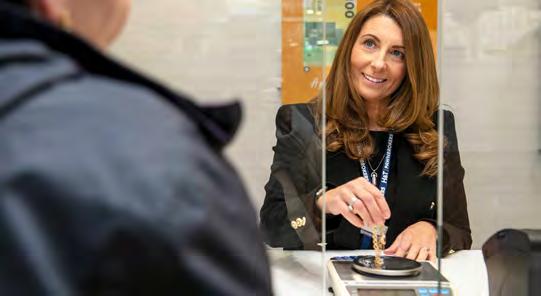
The shares remain attractively valued, trading on a single-digit multiple of Shore Capital’s 2023 and 2024 earnings estimates and offering a ripe dividend yield of 5%.
Pawnbroking struggled during the pandemic as lockdowns blocked off many avenues for spending and enabled people to pay down debt, but the industry is now experiencing a boom as financially distressed customers seek cash to help make ends meet.
A loan from a pawnbroker is appealing during straitened economic times as it is often the easiest way for consumers, many with poor credit histories, to obtain a quick loan and help pay their bills. Given the worsening UK economic backdrop, investors have bid up the share prices of H&T and rival pawnbroker Ramsdens (RFX:AIM) accordingly.
Founded in London in 1897 as Harvey & Thompson, H&T celebrated its 125th anniversary in 2022, a year of strong growth across the business. First-half results to June 2022 showed a 43% surge in pre-tax profit to £6.7 million amid continued momentum in the core pawnbroking business. Shore Capital forecasts full year adjusted pre-tax profits jumping from £10 million to £19.1 million with year-end net asset value per share of 377p. It estimates the company will grow pre-tax profits to £32.6 million in 2023 and £39.2 million in 2024.
Last year saw H&T acquire watch servicing and repair centre Swiss Time Services for £4.3 million in an earnings-enhancing deal that adds a new skill to its product offering.
The Sutton-headquartered company then raised £16.9 million of fresh capital by issuing new shares at 425p to support loan book growth and store estate expansion. Tellingly, chief executive Chris Gillespie and finance director Diane Giddy both participated in the fundraise, demonstrating their confidence in the outlook.
Speaking to Shares, Gillespie points out that over a decade ago, the UK pawnbroking market consisted of roughly 2,000 shops. Today, that number has dwindled to about 800, but H&T is a much bigger business than it was back then and is now the largest pawnbroker in the UK.
Before 2019, H&T’s growth strategy was mainly orientated around unsecured personal lending, which the company went into ‘with gusto in about 2013/2014’, says the CEO, but H&T has since exited the unsecured lending market.
‘We’re now focused on what we’re good at, pawnbroking and jewellery retail. And we do other things such as foreign exchange, holiday money, cheque cashing and Western Union money
transfer,’ he stresses. In fact, H&T is Western Union’s largest UK carrier by transaction volumes and that service attracts many people to its stores.
Trading is improving as the company catches up on historical underinvestment in stores and IT. Furthermore, the broader market for lending small sums of money is shrinking due to tighter regulation making that activity uneconomical for many firms, yet that gives H&T an opportunity. ‘Our median loan is £200. People now need to borrow and are finding that the chances are whoever they used to borrow from isn’t there anymore, and we are.’
Inflation is also eating into peoples’ disposable income, so they are turning more to pawnbrokers.
Gillespie believes that with 270 shops, H&T speaks for around 60% to 65% of the UK pawnbroking market by size of pledge book. The next biggest listed pawnbroking player is Ramsdens, though pawnbroking isn’t its core business and the company’s pledge book is less than 10% the size of H&T’s.
‘Most of our competitors are local businesses that have one or up to five or six shops, and in any one location they would be a fairly potent competitor, but they don’t figure on a national market share scale,’ he explains. ‘We are by a considerable margin the largest and that’s a combination of geographic reach and focus nationally.’
Despite being the UK pawnbroking leader, H&T
Put simply, a pawnbroker lends money based on the value of a customer’s item. After the customer hands over the item – the official term for this is ‘pledged’ – the pawnbroker securely stores the item until the customer pays the loan back in full, plus interest.

Pawnbrokers offer secured loans, which means money is lent against personal property. For those that need to borrow money but can’t get a traditional loan or credit card, a pawn shop can offer a helpful alternative.
remains under-represented in parts of the country such as Wales and the West, the North-West, Lincolnshire and the East, so there is plenty of room for expansion in the opinion of Gillespie and Giddy. There are also towns and cities where H&T has one outlet which could support a second or third shop, Bradford being one example.
SECOND-HAND PRODUCTS PROVIDE EXTRA SPARKLE
Shares readers might be surprised to learn that H&T is the sixth largest jewellery retailer in the UK. ‘Between 82% and 85% of what we sell is
Financial year to December Pledge book (£m)
2019 (A) 72.2
2020 (A) 48.3
2021 (A) 66.9
2022 (F) 100.4
2023 (F) 117.4
2024 (F) 123.3
Table: Shares magazine • Source: H&T, Shore Capital.
pre-owned,’ enthuses Gillespie, ‘and pre-owned is the growth segment of the jewellery market, particularly watches.’
Benefiting from increasing demand for secondhand jewellery, H&T is also profiting from the desire for customers with surplus cash to build a store of value, which can sometimes be sold back to the pawnbroker or pledged as collateral for a pawnbroking loan in the future.

Gillespie tells Shares the group’s pre-owned offering ranges from a pair of earrings for a tenner at one extreme to watches up the £20,000 to £25,000 range at the other. ‘Our average watch is a bit under £1,000 in terms of price, so a sizeable purchase but an aspirational one for a normal person,’ he explains.
Swiss Time Services looks a savvy acquisition for H&T, which sends thousands of watches a year away for servicing and repair before putting them up for sale. ‘We will increasingly bring that work, and the margin on that work, in-house and we’d like to offer a care and repair service to our
Chart: Shares magazine • Source: Refinitiv
customers,’ says Gillespie.
A high gold price benefits the gold purchasing business, which goes hand-in-hand with pawnbroking, but Gillespie says gold buying has become a much smaller proportion of the business than was historically the case.
Gold price movements have limited impact on H&T’s pawnbroking because its typical loan is a few hundred pounds and almost no impact on the price of a piece of retail jewellery.
IS H&T ONLY A SHORT-TERM WINNER? ‘The rate of growth that we’ve seen over the last 12 months or so and the store openings means that we are consuming rather than generating cash and that’s why we did the capital raise,’ says Gillespie, who believes countercyclical H&T can continue to flourish even in a more benign economic environment.
‘I’m not sure the supply of small sum credit issue is going to change any time soon,’ he explains. ‘That environment will be with the economy for a while and therefore pawnbroking is a growth opportunity for quite some time.
‘And as economic conditions become more benign – I’m not sure that is going to be the case for a year or two – you’ll probably see the jewellery retail side of our business being slightly larger in terms of its growth potential and trajectory. At the moment, more of our growth is skewed towards the lending side.’
By James Crux Funds and Investment Trusts Editor
It may seem odd that announcing job cuts is enough to drive up a share price. After all, the fact roles are being cut would imply that life isn’t going well for the business. However, this does happen, just as we saw with Amazon (AMZN:NASDAQ) earlier in January when its shares briefly rose on news of 18,000 job cuts.

Aside from the costs associated with redundancies, reducing employees means trimming a company’s cost base. This factor is why investors get excited at such news.
Michael Burry rose to fame when he was portrayed by Christian Bale in the 2015 film The Big Short. The hedge fund manager was among the first investors to spot serious problems in the US subprime mortgage market which went into meltdown in 2007.
Burry posted a message on Twitter expressing his shock at the market reaction last week to Salesforce (CRM:NYSE) announcing plans to cut 10% of its workforce, news that drove a near-4% rise in its share price. Referring to Salesforce’s stock code CRM, he said: ‘CRM should have been down 25% on those job cuts.’
Slowing demand has led Salesforce to look at its staffing needs. Like many tech companies, it hired a lot of people after the pandemic drove increased demand for digital services. Boardrooms across the tech sector were abuzz with senior management predicting this heightened demand would be permanent. Sadly, it has not proved to be true, leaving Salesforce and many other tech companies with no other choice but to trim their cost base.
Burry received a lot of criticism on Twitter
following his comment, with many people saying he was wrong and that job cuts had been widely requested by investors and that adjusting staff numbers was overdue. However, one person suggested that hiring and not firing during a difficult period might create better morale and ultimately a more productive workforce. Food for thought.

A lot of senior management seem to be very short term in their thinking. Life is tough now, but will it be the same in six months’ time? They might find it hard to rehire good people if demand suddenly picks up again.
Time will tell for Salesforce, but it is wrong to assume that a share will always go up on job cuts. Investors should look at the bigger picture and work out why workforce cuts are happening, what it says about a business’ fortunes and whether there is a risk that the remaining staff could be overworked because they’re having to take on additional duties. You also need to assess if the drop in demand that caused the job cuts is structural or cyclical.
Ultimately the fundamentals of a company should be more important to your investment decision-making that chasing a short-term market reaction to a quick cost saving measure.
Investors have applauded Amazon and Salesforce for reducing the size of their workforce
CRM should have been down 25% on those job cuts”
Michael Burry
On the other hand the demand picture seems to be getting worse
There is growing evidence from industrial surveys that supply chains are starting to ease in some areas of manufacturing, although the global economy is still far from ‘normal’ as we enter 2023 and a return to growth is a long way off.
According to the IFO research institute, companies in Germany are experiencing ‘noticeably fewer’ material shortages than previously.
In December, 50.7% of manufacturing companies surveyed said they had experienced problems compared with 59.3% in November, marking three consecutive months of easing supply shortages.
Shortages were still acute for makers of cars and industrial equipment, but those relying on commodities such as chemicals, paper or raw metals saw far fewer problems, with even timber and wood products for the building industry in reasonable supply.

The December Global Manufacturing Purchasing Managers Survey, produced by J.P.Morgan (JPM:NYSE) and S&P Global (SPGI:NYSE), flagged ‘signs that the outlook for production volumes may be stabilising, as business optimism rose to a fourmonth high and the cyclically sensitive new ordersto-finished goods inventories ratio edged higher’.
The survey said input inventories fell as companies were able to use ‘safety stocks built up in response to supply disruptions earlier in 2022’.
There was also good news on prices, as the rate of inflation in input and output costs fell to its lowest in two years.
Anecdotally, several UK firms have pointed to easing supply chain pressures of late.
Mobility solutions group Redde Northgate (REDD) and logistics firm DX (DX.:AIM) both told Shares recently that the supply of light commercial vehicles, essential for both their businesses, had improved significantly since the summer.

On 4 January computer board and systems maker Concurrent Technologies (CNC:AIM) raised its revenue forecast for 2022 thanks to an easing of supply chain pressures which enabled it to step up production in November and December resulting in record sales.
It isn’t all good news, however, as the same industrial surveys are pointing to a sharp slowdown in new orders as the economy cools.
According to the Global Manufacturing PMI Survey, new orders fell at the quickest pace for over two-and-a-half years in December with new export business ‘declining to one of the greatest extents since mid-2020’.
The UK Manufacturing PMI Survey says the decline in new business in December was ‘worryingly steep, as weak domestic demand was accompanied by a further marked drop in new orders from overseas’.
Material technology group HEIQ (HEIQ) warned last week that its customers were ‘more hesitant to invest in innovations’, leading to delays in orders and milestone payments, causing its shares to fall 50% in a day.
By Ian Conway Companies Editor

Oil and gas prices are down so far in 2023 and both are trading back where they were a year ago. If central bankers, politicians, companies and consumers are looking for good news when there seems to be so much bad around, this is it.
Higher energy prices stoke inflation, crimp corporate profit margins and act as a tax on consumers. The reverse therefore holds true, so oil and gas price weakness would be a massive bonus for all four groups and potentially financial markets, too.
Should the prevailing rate of inflation ease and keep doing so, then central bankers can pause on rate hikes and then pivot to rate cuts – or at least that’s the theory.
For the moment, analysts seem inclined to believe that oil and gas prices are going to fall in 2023 and 2024, because they are forecasting a one-third fall in operating profit from the West’s seven oil majors between 2022 and 2024 (and that is before any change in interest bills or taxes).
The question is whether they are right, and there are five factors which investors may need to follow to see which trajectory energy prices will take in 2023 and beyond.
Analysts’ earnings forecasts imply lower oil and gas prices for 2023 and 2024

History shows it doesn’t make much of a drop in oil consumption to hit the price hard, given how delicate the balance between supply and demand tends to be. Crude prices plunged in 1980, 1991, 2001, 2008 and 2020 as recession hit home and a slowdown or downturn in 2023 could see a repeat. Oil traders took fright in the second half of 2022 and have been running scared in early 2023, especially as the world’s second biggest economy,
China, has struggled to reopen as quickly as some hoped.
Oil and gas prices can be surprisingly sensitive to GDP growth

strategic petroleum reserve down to 375 million barrels, way below the maximum capacity of 714 million and a figure last seen in December 1983. Sharp drops in regular stockpiles could boost US demand in the future, especially as the Biden administration seems dead set against further drilling on environmental grounds, and at some stage America will surely want to replenish its reserves to buttress its national energy security.
Equally, if the pandemic and lockdowns have constrained demand for the thick end of three years so if the Middle Kingdom can finally shake off Covid then there is a chance that oil demand will increase. OPEC is forecasting an average increase in demand of 700,000 barrels a day from China and this underpins the cartel’s estimate that global demand will rise by some 2.7 million barrels a day in total in 2023.
A peaceful solution and a Russian withdrawal from Ukraine – prompted either by international sanctions or internal pressure – could help oil supply, or at least take the pressure off some key pipelines.
However, sanctions, or price caps, on Russia, Iran and Venezuela, as well as ongoing instability in OPEC member Libya, could all constrain supply, while OPEC also seems keen to manage its output so that oil prices are well underpinned and production cuts remain a key tool in the cartel’s armoury. With demand still forecast to grow, any restraint on oil supply could boost the price.

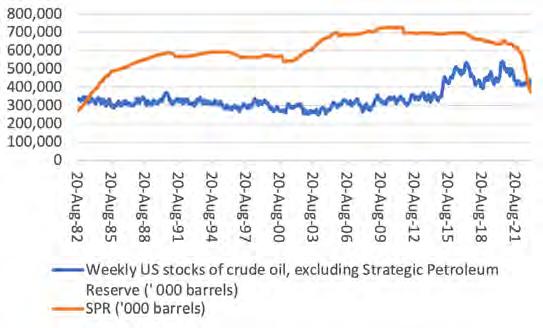

To try and put a lid on oil, the US has taken its
OPEC’s World Oil Outlook document from 2022 forecasts that renewables (mainly wind and solar) will be the fastest growing source of energy supply between now and 2045, with gas playing a much bigger role, nuclear, hydro and biomass chipping in, oil coming in broadly flat and coal going into steep decline. If even OPEC is forecasting this, bears of oil will argue, then there must be a real danger that oil fields become stranded assets as other sources of energy come to the fore.

Given public and political pressure not to invest in hydrocarbon supply on environmental grounds, oil majors are taking heed, for fear of reputational damage, regulatory attention, windfall taxes or a combination of all three.

Capex is rising again but the aggregate numbers from the West’s oil majors include investment in renewables and alternative energy sources. They also leave the aggregate capex budget at barely half of the 2013 peak in dollar terms; at just one times depreciation compared to the 2013 high of nearly two times; and the capex/sales ratio at just 7.6% by 2024, again a long way below the 2015 zenith of 13%.
If oil demand does surprise on the upside in any way, these numbers could provide support

The automotive sector is in flux amid a transition to electric and hybrid vehicles as well as developments in assisted driving technology and frequent changes in safety and regulatory standards. That’s good news for UK engineering champion AB Dynamics (ABDP:AIM) which is one of the best performing AIM companies of the last decade.

If you invested £1,000 when the company floated in May 2013, you would be sitting on a stake worth £16,000 today, less any transaction or investment platform fees. That same £1,000 invested in a FTSE 100 tracker would be worth just £1,450, with both calculations based on total return data from SharePad.
Before the pandemic the returns on a long-term investment in AB Dynamics shares would have looked even more impressive. Supply chain issues affecting the wider industry hit the company’s profit, and the current share price of £16.11 compares with peaks above £27 in 2019.
That pullback in the share price might interest investors looking for a better entry point into this unique business on the UK stock market.
Founded more than four decades ago by Anthony Best, who served as chairman until 2021, AB Dynamics provides testing systems to the automotive industry from its Wiltshire base.
Customers include the 25 largest automotive manufacturers, key tier-one suppliers (the businesses which provide the components and devices used in the manufacture of cars) and large technology companies. It even counts the Alfa Romeo Formula One team among its clients.
These companies use AB Dynamics’ products for vehicle testing; ADAS (advanced driver assistance systems) development; driverless car technology evaluation; suspension, chassis and steering system development; and noise, vibration and harshness testing.
Its products and services include advanced driving simulators, driving robots and precision soft targets – effectively inflatable to-scale cars, motorbikes and other road users – for track testing.
‘With eight mandatory ADAS features required
in all cars sold worldwide by May 2024, and a push towards autonomous vehicles that require extensive reliance on simulators and laboratory testing to optimise development, we believe that AB Dynamics’ premium positioning will enable it to benefit from strong demand tailwinds,’ says investment bank Berenberg.
Despite pressure on profitability resulting from the pandemic, a supply chain squeeze and investment in new ventures, AB Dynamics still generates strong returns with an operating margin of 15.8% in the year to 31 August 2022.
While there is no suggestion AB Dynamics sees a lack of longer-term opportunities in its core automotive sector, the company has begun to diversify. Its newly launched ABD Solutions business offers easy-to-install, retrofit kit which can transform a standard vehicle to an autonomous one.
Recognising that widespread adoption of automated vehicles for road-use remains some way off, it is targeting the mining, defence and specialist industrial sectors. Its solution could, in theory, help rapidly and cheaply reduce costs and safety risks in these industries.

Chief executive James Routh acknowledges to Shares it will take time to build scale in this new division which is currently guided to make a positive contribution to earnings in the financial year ending August 2024.
Routh says: ‘We’re not guiding for huge things straight away. In mining and defence applications which are safety critical there is a lot of emphasis on getting it right and that’s going to take longer as a result, whereas we should be able to convert specialist vehicles on waste management sites a lot quicker, but these are smaller contracts.’
Meanwhile, regulatory changes are providing support to the core business. The European New Car Assessment Programme recently published its 2030 roadmap. As Liberum analyst Sanjay Vidyarthi observes: ‘The test scenarios continue to get more complex, requiring new permutations such as changing weather conditions, different types of vulnerable road user (e-scooters) and, increasingly, the interaction between the driver and ADAS features.
‘We think this will play into AB Dynamics’ suite
of simulation and track testing products, a point supported by the fact that all of its ADAS test platforms and targets have now been approved for use in Euro NCAP testing ahead of the introduction of the new 2023 protocols,’ adds Vidyarthi. This has significance outside the continent itself as Europe often leads the way on safety standards.
Companies with regulatory-driven business are often rewarded with bumper equity valuations and AB Dynamics is no exception, trading on 32 times forecast earnings for the 12 months to 31 August 2023.
In the short term this might make an investment in the stock more of a risky proposition but longer term the growth prospects look excellent and it is a well-run business with an impressive track record.
AB Dynamics has a very strong balance sheet with net cash of £29.3 million. Cash flow generated from operations has increased from £2.1 million in the 12 months to 31 August 2013 to more than £20 million in the last financial year.
Self-funded acquisitions to supplement organic growth seem plausible. Routh says the company is debt averse, with its financial strength offering reassurance to its customer base. The company pays a modest dividend, but the yield is nominal at best at around 0.3% based on consensus forecasts.
By Tom Sieber Deputy Editor
Asset manager Brown Advisory forces managers to sell or buy more when an investment falls by 20% or more
Of all the challenges facing you as an investor, the father of value investing Benjamin Graham said the chief one and the ‘worst enemy’ is likely to be yourself. One asset manager which seems to have taken this lesson to heart is Brown Advisory. Portfolio manager Mick Dillion, who helps steer the Brown Advisory Global Leaders Fund (BYPJ0V0), told Shares the team apply a set of rules to help them navigate deep rooted behavioural biases.
The chief problem, explains Dillon is that the oldest part of the brain, called the hippocampus developed millions of years ago when humans were roaming around on the savannah. That part of the brain is very instinctive and good in ‘fight or flight’ situations where split seconds can mean the difference between escape and becoming a meal for a predator.
It is not very useful however, in the world of investing where deep thinking and reflection are

needed. This is performed by the ‘system two’ part of the brain or neocortex. In times of stress, (falling share prices) system one takes over and does everything it can to avoid pain and loss. Because it is ‘hard-wired’ into our brains, it is difficult to ignore.
That’s why Brown Advisory has developed a set to rules which forces the managers to act when a shareholding falls 20% or more. The natural response explains Dillon is to do nothing, rather like the proverbial rabbit in the headlights. Effectively investors are caught between a rock and a hard place. If they don’t sell, the pain gnaws away and if they sell and the stock recovers, they suffer regret.
Instead, fund managers at Brown Advisory are forced to either buy more or sell. This awakens the system two part of the brain and rationality takes over, at least in theory.
In such situations over the last six years the team have added to positions more than twice as many times as they sold but the hit rate (successes to failures) has remained at 67% and 76% respectively, demonstrating rational decision making in the heat of the moment.
As impressive as a two-thirds hit rate is, it still means getting a third of decisions wrong. Dillon likens it to football where stats on passes completed show no team ever achieves 100% accuracy.
During the early days of the pandemic the team were presented with an unusual situation with German event ticketing company CTS Eventim (EVD: XETRA). Advanced sales of tickets had to be returned when events were cancelled, which

meant entertaining the idea that the business might have negative sales.
The team were concerned the company might run out of cash before the economy could reopen. Many scenarios were contemplated, but they eventually settled on the decision to buy more shares. The thinking was that it might take three years to develop a vaccine and one year to inoculate the population. The shares now trade above their pre-pandemic levels.
The investment style of the fund is probably best described as bottom-up stock picking with a preference for high quality businesses and rational management teams acting in the best interests of shareholders. The aim is to build a high conviction portfolio of attractively valued businesses. The fund’s largest position is software giant Microsoft (MSFT:NASDAQ) which represents 7.5% of the portfolio. Dillon likes Microsoft’s cloud business which represents half of sales.

A recent addition to the portfolio was Taiwan Semiconductor Company (TSM:NASDAQ) which was bought before famed investor Warren Buffett announced Berkshire Hathaway (BRK.A:NYSE) had purchased a $5 billion stake.


Dillon said the combination of a big drop in the shares on fears of a Chinese invasion of Taiwan and the ubiquity of TSMC’s chips which run some 40% of global electronics were key attractions that led to the purchase.
By Martin Gamble Education Editor
I’d be interested in a high level run through of pension recycling rules as it seems a very grey area. For example, if we were to have more disposable income if we paid off our mortgage with my pension lump sum, would it be OK to pay more money into my self-employed partner’s pension?
Or is that recycling?
Mike
HMRC has rules in place designed to prevent people manipulating the pension system to get extra tax relief. As you say, this concept is referred to by the taxman as ‘recycling’ and applies specifically to your use of the 25% tax-free lump sum entitlement.
It’s probably easiest to demonstrate how recycling might work with an example. Let’s assume someone is 65 years old and has a SIPP valued at £40,000. They take out their maximum tax-free lump sum (£10,000) but rather than spending it, invest it straight back into their SIPP.
As a result, they get basic-rate tax relief on the ‘new’ contribution (immediately boosting the value of the contribution by £2,500 to £12,500) and can then access 25% of that money (£3,125) tax-free as well.
Clearly such behaviour presents a significant risk to the Treasury – which is why HMRC has rules in place designed to prevent excessive recycling. Anyone who breaks these rules risks being hit with an unauthorised payment charge of 40% or 55% (depending on the circumstances) of the contribution.
HMRC will consider recycling to potentially breach the rules where the tax-free lump sum
(or sums) received over a 12-month period are worth more than £7,500.
The rules kick in where the payment of a tax-free lump sum has resulted in a 30% or more increase in contributions to your pension compared to what might normally have been expected.
Although this might sound a bit vague, it’s actually a specific condition – HMRC looks at contributions paid in the rest of the tax year after you took your tax-free cash plus up to two more years afterwards. This is then compared with the contributions made during a similar period before tax-free cash was taken.
You can’t get round this by paying into different pension schemes as HMRC will look at all of your contributions when making its assessment.
Equally, HMRC will penalise you for recycling if you borrow money to pay contributions or pay into your pension out of savings and then use the taxfree lump sum to pay off the loan or top up savings.

If you are at all uncertain about how these rules might apply in your specific circumstances, it’s worth speaking to a regulated financial adviser before doing anything, particularly if you’re thinking about making large contributions.
Send an email to asktom@sharesmagazine.co.uk with the words ‘Retirement question’ in the subject line. We’ll do our best to respond in a future edition of Shares.
Please note, we only provide information and we do not provide financial advice. If you’re unsure please consult a suitably qualified financial adviser. We cannot comment on individual investment portfolios.
HMRC will penalise anyone looking to manipulate the system to get extra tax relief
avoid
big penalty?Tom Selby, AJ Bell Head of Retirement Policy, says:

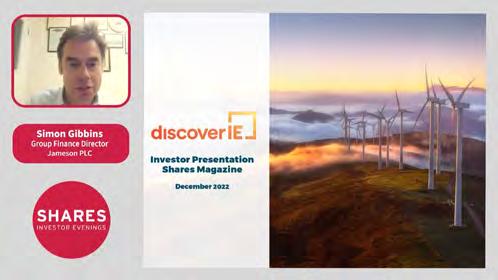
Simon Gibbins, Group Finance Director & Lili Huang, Head of Investor Relations
discoverIE Group plc (DSCV) is an FTSE 250 international electronic engineering company that designs and manufactures customised electronic components for industrial use. It provides application-specific components to original equipment manufacturers (OEMs) internationally, with a focus on key markets.



Ian Simm, Founder & Chief Executive
Impax Asset Management Group (IPX) offers a range of listed equity, fixed income and private markets strategies. All strategies utilise the firm’s specialist expertise in understanding investment opportunities arising from the transition to a more sustainable economy.
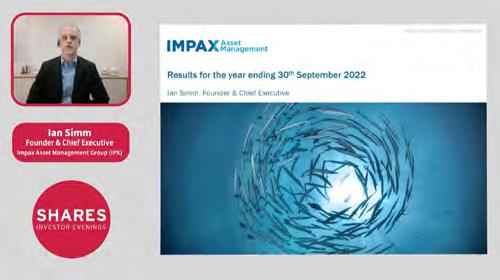
Adam Davidson, CEO
Trident Royalties PLC plan to rapidly establish itself as a diversified mining royalty and streaming company, providing investors with exposure to base and precious metals, bulk materials (excluding thermal coal) and battery metals.
Visit the Shares website for the latest company presentations, market commentary, fund manager interviews and explore our extensive video archive.
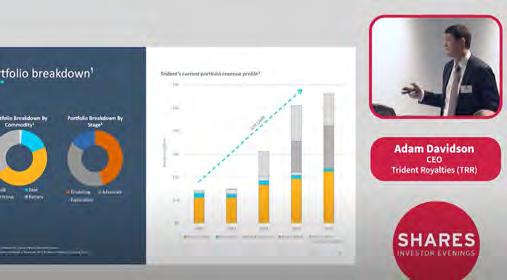
The new year is here – and it brings with it a raft of changes that will impact your pocket or pay packet. Here are the big changes to look out for in 2023.

Anyone with non-barcoded stamps will find they are officially not usable from 31 January. However, the Royal Mail has introduced a six-month grace period, which means you can still use them until 31 July. It means you either need to use up the stamps or swap them for new ones. Anything posted with an old stamp after the grace period will be treated as though it has insufficient postage.
Usually rail fares rise in January, but the Government delayed the increase to 5 March this year. However, fares will then rise by 5.9%, a whopping amount compared to recent history. The price increase, which was announced by the Government just before Christmas, applies to half of all tickets, including
season tickets. Other fares that are not regulated could rise by more.
The point at which people pay the highest rate of income tax (45%) will be reduced from the new tax year, from £150,000 to £125,140. The move means that someone earning £150,000 a year will pay almost £1,250 a year extra in tax.
On top of this move the basic and higher rates of income tax are frozen again – meaning taxpayers will see a higher tax bill than if the thresholds had risen in line with inflation as they usually do. It means that anyone who gets a pay rise could be hit with a higher tax rate, as well as potentially losing certain allowances, such as child benefit or their personal allowance.
The new tax year will also bring a tax crackdown on investors, as the tax free amounts for
Stay on top of the big moves on tax, benefits, energy bills and more for the year ahead
capital gains and dividends will be cut. It means the amount of dividend income you can receive before paying tax will be reduced from £2,000 to £1,000, costing a higher-rate taxpayer up to £338 more in tax. Meanwhile, the tax-free amount for capital gains will be chopped from £12,300 to £6,000, costing a higher rate taxpayer up to £1,260 a year more for non-property gains.
Ahead of the deadline it’s a good idea to move money into an ISA (or pension) if you have sufficient ISA allowance remaining. Alternatively you could transfer assets to your spouse to use their allowances.

The Government has changed the rules for local councils, meaning they can increase council tax by up to 5% without seeking a referendum. It means that many people will see council tax bill increases up to this limit, as many local authorities are struggling with funding. If rates increase by 5% it means the average Band D property in the UK will pay £2,064 a year for council tax – an increase of almost £100 on 2022’s bills.
Anyone on the state pension will see a 10.1% increase to their payouts from April. As a result, the full flat-rate state pension will rise to over £10,000 a year for the first time, while the basic state pension, paid to those who reached state pension age before 6 April 2016, will increase to over £8,000 a year.
On top of this, other benefits will increase by the same amount, including Universal Credit and child benefit.
The current iteration of the Government’s Energy Price Guarantee ends in April. It will be continued but the cap will be placed at a higher level, meaning that the average household energy bill for electricity and gas will rise
from £2,500 a year up to £3,000 a year – although in reality lots of people will pay far more if their energy use is above average.
On top of this, the Government hasn’t said if it will be providing the universal £400 off energy bills that it handed out to every household in 2022 and if it is repeating the £150 council tax rebate. This means that the average household could face an extra £1,050 a year in energy costs from April.
As with 2022, certain people will get handouts to help with the cost of living, with the first payments coming from Spring. Those on certain means-tested benefits, including Universal Credit and pension credit, will get £301 in the spring, another £300 in the autumn and then a final £299 in spring 2024.
Those on disability benefits will get a £150 handout this summer, while pensioners will get an additional £300 in their Winter Fuel payments this year (or in early 2024). The exact payment windows will be revealed closer to the time, including the eligibility periods for them.
By Laura Suter AJ Bell Head of Personal Finance
COMPANY PLC (LON: ART)
A curator and provider of premium single cask Scotch malt whisky and other spirits for sale primarily online to a discerning global membership.
MERCIA ASSET MANAGEMENT (LON:MERC)

A proactive, specialist asset manager focused on supporting regional SMEs to achieve their growth aspirations.
OROCO RESOURCE CORP (TSX-V:OCO.V)
The Santo Tomas deposit is an emerging copper giant, with a multi-million tonne resource demonstrated by historical exploration.


RAMSDEN HOLDINGS PLC (LON: RFX)

A diversified financial services provider and retailer operating in the following core segments: Foreign currency; Pawnbroking; Purchases of precious metals segment; Jewellery retail segment and Income from other financial services.
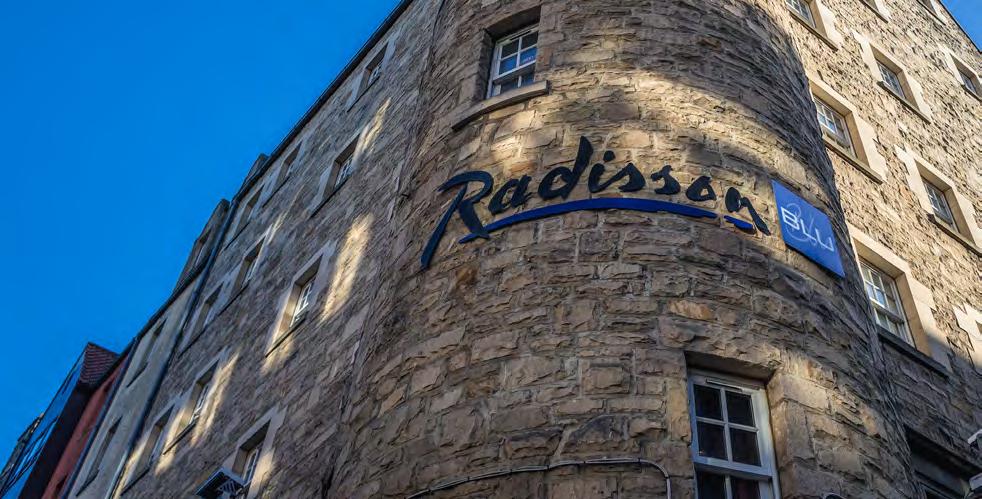
Shares publishes information and ideas which are of interest to





It does not provide advice in relation to investments or any other financial matters. Comments published in Shares must not be relied upon by readers when they make their investment decisions. Investors who require advice should consult a properly qualified independent adviser.
its staff and AJ Bell Media Limited do not, under any circumstances, accept liability for losses suffered by readers as a result of their investment decisions.

Members of staff of Shares may hold shares in companies mentioned in the magazine. This could create a conflict of interests. Where such a conflict exists it will be disclosed. Shares adheres to a strict code of conduct for reporters, as set out below.
1. In keeping with the existing practice, reporters who intend to write about any securities, derivatives or positions with spread betting organisations that they have an interest in should first clear their writing with the editor. If the



editor agrees that the reporter can write about the interest, it should be disclosed to readers at the end of the story.
Holdings by third parties including families, trusts, self-select pension funds, self select ISAs and PEPs and nominee accounts are included in such interests.
2. Reporters will inform the editor on any occasion that they transact shares, derivatives or spread betting positions. This will overcome situations when the interests they are considering might conflict with reports by other writers in the magazine. This notification should be confirmed by e-mail.
3. Reporters are required to hold a full personal interest register. The whereabouts of this register should be revealed to the editor.
A reporter should not have made a transaction of shares, derivatives or spread betting positions for 30 days before the publication of an article that mentions such interest. Reporters who have an interest in a company they have written about should not transact the shares within 30 days after the on-sale date of the magazine.